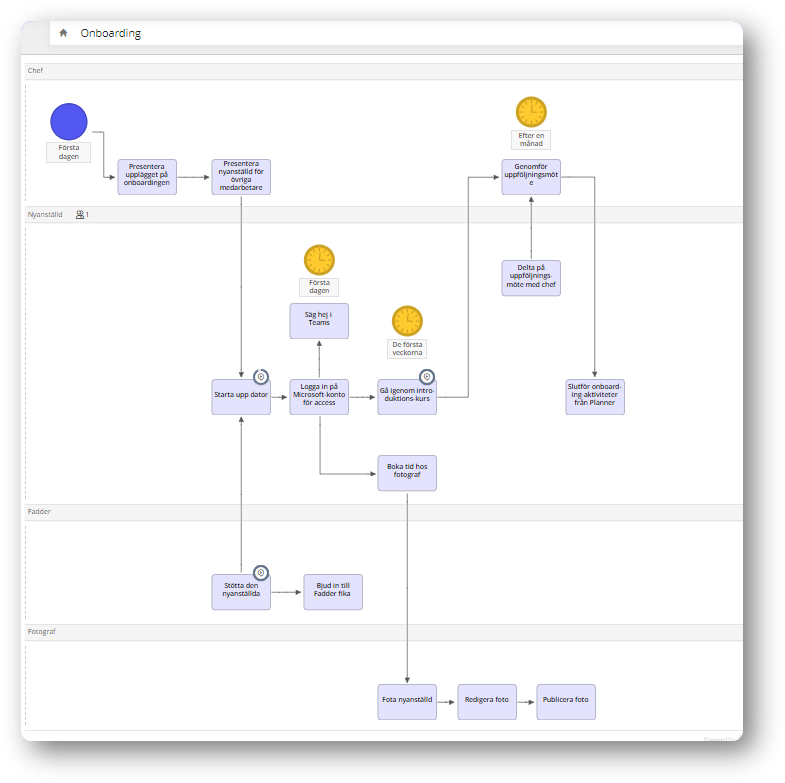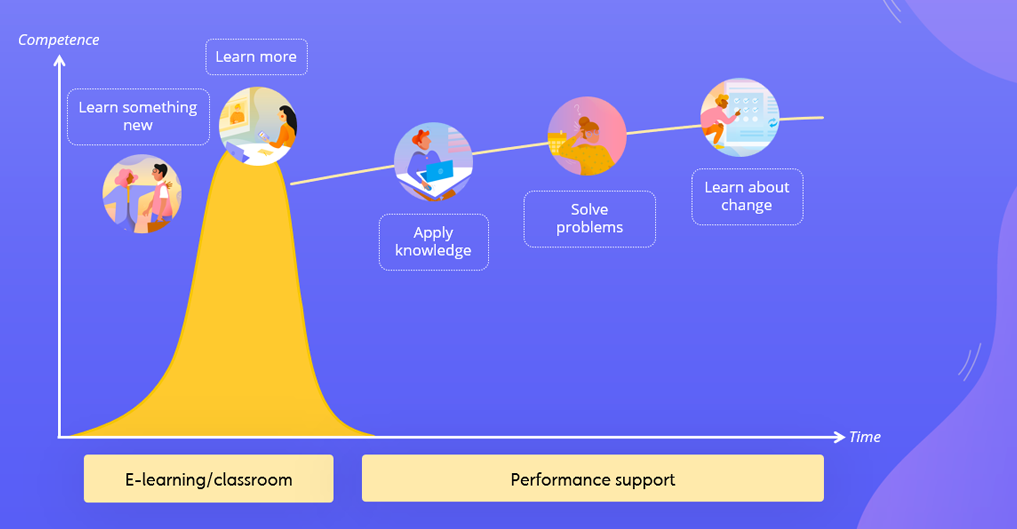Effective Implementation of New Systems
Through adapted learning methodology and the use of InfoCaption's learning tools, we give you the conditions to provide effective and safe support during system implementation.
Let’s connectTailored Learning Methodology with InfoCaption's Tools
By leveraging InfoCaption's educational tools, we set the stage for providing effective and reliable support during system implementations. Our platform supports the entire journey—from initial introduction and training to ongoing assistance after the system goes live. It's easy to create, share, and manage content, ensuring a smooth and user-friendly experience for all users.
Addressing Diverse Learning Needs During Change
During significant transformation projects, such as implementing new systems, various learning needs arise that require different types of educational support. Employees need both a broad overview and detailed guidance for specific tasks. The former can be addressed through packaged e-learning, while the latter necessitates short, accessible how-to guides available directly within their workflows.
Common pitfalls in system implementation
We've identified four pitfalls frequently encountered in change projects:
Overemphasis on the introduction phase leads to temporary gains
Organizations frequently focus heavily on introducing new systems, trying to cover everything employees need to know. While this approach is important, cramming too much information into the introductory session can backfire. It tends to be resource-heavy for both trainers and participants and often leaves attendees struggling to remember what they've learned.
Insufficient support can lead to costly mistakes
When too many resources are focused on the initial phase, there's a risk that employees won't have enough support when it comes time to perform specific tasks.
They might end up spending valuable time searching for the correct information, which can be frustrating and resource-draining when they just want to get things done. Alternatively, they may guess what to do, which naturally increases the chances of making costly mistakes, both financially and in terms of time.
Inadequate support can create stress and uncertainty
Not receiving enough assistance can have even greater consequences than just time and money. It’s highly likely to lead to stress, frustration, and insecurity among employees, contributing to a negative work environment.
Challenging to communicate continuous changes
It’s important to remember that during major transformation efforts, the initial period (even after implementation) often involves significant changes. This could include functional changes in the system or adjustments related to processes. Unfortunately, there is often a lack of a clear plan for how to communicate these ongoing changes effectively.
Common pitfalls in system implementation
Overemphasis on the introduction phase leads to temporary gains
Organizations frequently focus heavily on introducing new systems, trying to cover everything employees need to know. While this approach is important, cramming too much information into the introductory session can backfire. It tends to be resource-heavy for both trainers and participants and often leaves attendees struggling to remember what they've learned.
Common pitfalls in system implementation
Insufficient support can lead to costly mistakes
When too many resources are focused on the initial phase, there's a risk that employees won't have enough support when it comes time to perform specific tasks.
They might end up spending valuable time searching for the correct information, which can be frustrating and resource-draining when they just want to get things done. Alternatively, they may guess what to do, which naturally increases the chances of making costly mistakes, both financially and in terms of time.
Common pitfalls in system implementation
Inadequate support can create stress and uncertainty
Not receiving enough assistance can have even greater consequences than just time and money. It’s highly likely to lead to stress, frustration, and insecurity among employees, contributing to a negative work environment.
Common pitfalls in system implementation
Challenging to communicate continuous changes
It’s important to remember that during major transformation efforts, the initial period (even after implementation) often involves significant changes. This could include functional changes in the system or adjustments related to processes. Unfortunately, there is often a lack of a clear plan for how to communicate these ongoing changes effectively.
How we support your change project
Workflow overview:
Kickoff Workshops: Establishing project structures from the outset.
Regular Check-Ins: Providing ongoing support as the project progresses.
Potential Support Components:
-
Comprehensive project planning: Integrating training and support throughout the project.
-
Assistance with mapping new workflows.
-
Support in user and learning needs analysis methodology: Throughout the entire implementation.
-
Guidance on categorizing learning needs: According to the 5 Moments of Learning Need framework.
-
Support in setting up learning structures: Including portals, context-sensitive help, training templates, etc.
-
Customization of Templates and Portals: According to your branding guidelines.
-
Establishing Systems for Tracking Statistics and Usage.
-
Context-Sensitive Help within the System.
-
Training on the Platform.
-
Content Production: Available as needed.
Secure and efficient implementation of your new system
We provide support to establish project structures or assist operationally in creating training materials, instructions, and portals to make support easily accessible for your employees.
Each project has unique needs, but to give you an idea of how we can assist your team, we’ve listed several examples below!

End-User Analysis
At the outset of the project, we conduct a comprehensive end-user analysis (which can be done at various levels) that includes:
- Who are the end-users?
- What tasks will the end-users perform?
- What are their motivations?
- What support do the end-users need?
- In what format and how should the support be made available?

Mapping of Changed Workflows
When implementing new systems, business processes often undergo significant changes.
With InfoCaption's process tools or the workflow guide type, we can easily map out these processes and attach concrete instructions. This allows us to provide a broad overview of the new processes and support for the execution.

A Centralized Support Hub
With the InfoCaption portal, we can consolidate all information, whether webinars, training sessions, or shorter how-to guides.
We can, of course, customize it if you want separate portals for different roles.
End-users will receive suggestions for helpful support and can easily search for information as needed.

Introductory Course
Creating packaged courses that provide an overview of the change or system is often valuable. The purpose of these sessions is to give employees a solid introduction and a general understanding.
Therefore, we recommend that these packaged courses be kept at a relatively high level, without too much detailed information. The specific details can instead be covered during the "application phase" through short and accessible how-to guides.

Context-Sensitive Help Directly in the Workflow
To provide employees with support while they are performing tasks during their workday, we recommend using our context-sensitive help, which offers users assistance directly within their workflow. The tool detects where the user is and suggests guides that are relevant to the specific task they are working on. We advise using short how-to guides that are easy to understand, enabling users to quickly move forward with their tasks.
5 Moments of Learning Need
Addressing Different Learning Needs
During significant change initiatives, such as implementing new systems, various learning needs arise that require different types of learning support. For example, employees/users need both an overarching introduction to understand the system's components and detailed guidance on how to perform specific tasks within it. The first need can be relatively easily met with a packaged e-learning course. In contrast, the second need, where users require assistance during their workday, calls for accessible and concise how-to guides directly within the workflow.
Learn more about 5 Moments of Learning Need


